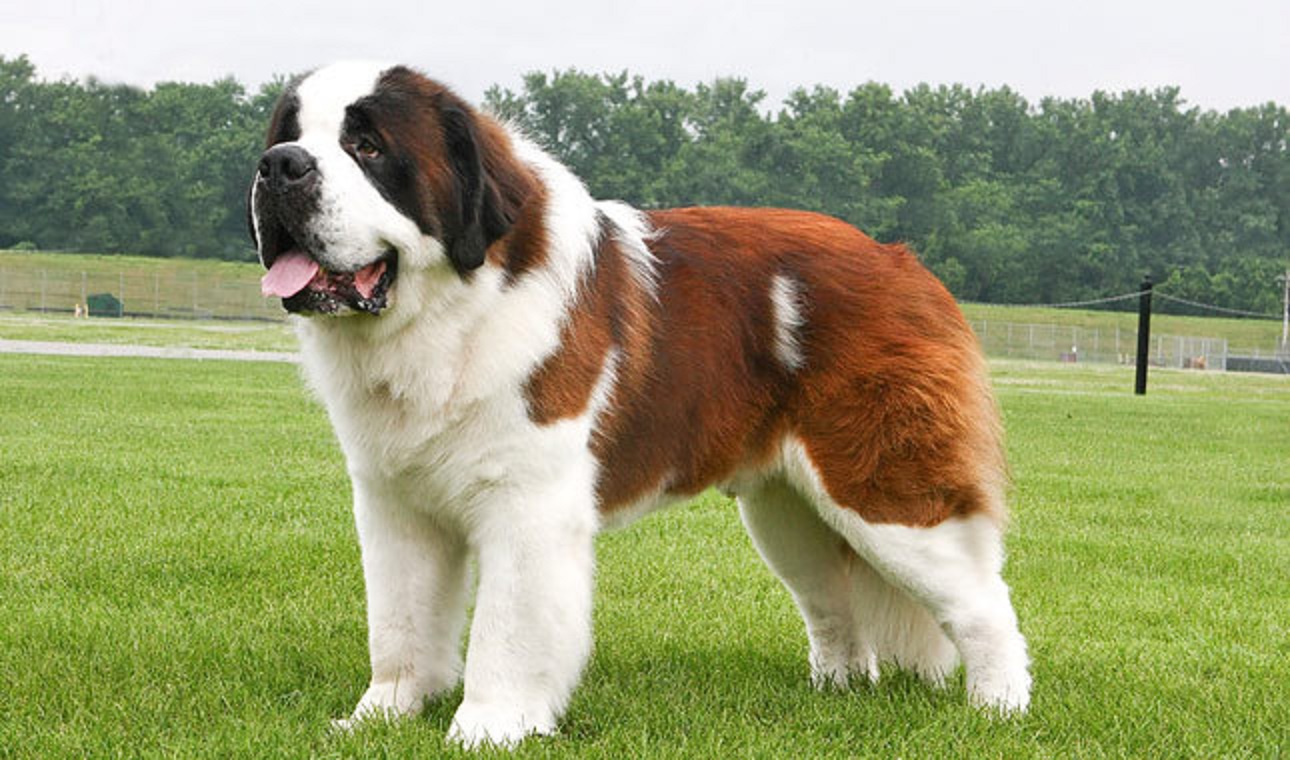
Saint Bernard

Navigate through the tabs
Navigate through the tabs below to view the breed's info of your interest.
The breed's info is divided in four sections; namely:
the breed's history ,
the breed's main stats ,
the dog's potential health issues
and finally, how the breed scored in 26 different categories.
All the above information should give you a respectively good overview for the dog of your interest.
Dog Breed's Main Info
The Breed's History:
The Saint Bernard originated in Switzerland along with several other breeds, including the Bernese Mountain Dog, Entlebuch Cattle Dog, Appenzell Cattle Dog, and Greater Swiss Mountain Dog.
They probably were created when dogs native to the Alps were crossed with Mastiff-type dogs that came with the Roman army during the time of the emperor Augustus.
By the first millennium CE, dogs in Switzerland and the Alps were grouped together and known simply as Talhund" (Valley Dog) or "Bauernhund" (Farm Dog).
The Saint Bernard Pass is a well-known and treacherous alpine pass that lies roughly 8,000 feet above sea level and can only be traveled between July and September. Today remnants of the great Roman road can be seen, as well as evidence of Napoleon's crossing.
Archdeacon Bernard de Menthon arrived at this pass, which would eventually be named after him, in 962 AD, and there he founded his hospice, which aided travelers who were overcome by crossing this treacherous pass. That's when the Saint Bernard's history began to branch out from the Talhund or Bauerhund.
It is unclear when the dogs were first used by the Hospice, but a painting depicting well-built shorthaired dogs that greatly resembled Saint Bernards as they are today was painted in 1695. The first written mention of the breed in the monastery's records was in 1703.
The dogs were probably originally used by the hospice monks to guard the grounds. When the monks went in search of lost travelers, they may have brought along the dogs for protection and discovered by accident that they were excellent pathfinders with an ability to locate helpless travelers.
The isolation of the monastery probably contributed to the refinement of the dogs into a breed that could withstand harsh winters and had the physical characteristics needed for their search and rescue work.
The Hospice's breeding stock was occasionally replenished by dogs from the lower valleys, many of which were puppies of the hospice dogs that weren't needed at the time of their birth. In 1830, the monks attempted to improve their dogs' coats by crossing them with the thick-coated Newfoundland.
That was a mistake. The longhaired offspring were inferior because ice built up in their longer coats. After that time, the monks gave away or sold any longhaired puppies they produced.
During the three centuries for which the Hospice has records, Saint Bernards were credited with saving more than 2,000 travelers. By the 1800s, the hospice dogs did not have a formal name, although they were well known. Between 1800 and 1810, a hospice dog named Barry was credited with 40 finds and became one of the most famous dogs to ever live. Often the dogs were referred to as Barryhunden in his honor.
The English referred to them as Sacred Dogs and imported many of them into England in an effort to reinvigorate their own Mastiff breed. In Germany, the name Alpendog was suggested for the breed in the 1820s.
In 1833, a man by the name of Daniel Wilson suggested that the breed be referred to as the Saint Bernard Dog, and that's eventually what they became when the Swiss Kennel Club recognized the breed in 1880.
When the breed began to be known in other countries, the Saint Bernard's type started to change. The Saint Bernards in other countries became thinner and taller, the by-product of crossbreedings. In 1887, the International Congress of Zurich drew up the first breed standard and all countries, except England, accepted it.
In the United States, a Saint Bernard named Plinlimmon became well known in 1883. Plinlimmon was owned by an actor and became the top-winning Saint Bernard show dog of his time. His owner took him across the country, exhibiting him at theaters.
In 1888, the Saint Bernard Club of America (SBCA) was founded, and the club accepted the breed standard written by the Swiss. Saints rank 39th among the 155 breeds and varieties registered by the American Kennel Club.
Today, Saint Bernards can be seen in homes, on the big screen, and at dog shows. There are still Saint Bernards at the Saint Bernard Hospice in Switzerland. They no longer seek out travelers in need but instead serve as living representatives of hospice history.
Country of Origin:
Italy / Switzerland
Breed Group:
Working
Height:
2 feet, 2 inches to 2 feet, 6 inches (66,04 to 76,2 cm)
Weight:
120 to 180 pounds (54,43 to 81,65 Kg)
Life Span:
8 to 10 years
Potential Health Issues:
Elbow Dysplasia,
Hip Dysplasia,
Entropion,
Epilepsy,
Dilated Cardiomyopathy,
Cataracts,
Allergies,
Gastric Dilatation-Volvulus (GDV)
Adaptability
Apartment Living:
First Time Owners:
Sensitivity:
Being Alone:
Cold Weather:
Hot Weather:
Friendliness
Affection With Family:
With Kids:
With Dogs:
With Strangers:
Health and Grooming
Shedding:
Drooling:
Easy To Groom:
Overall Health:
Weight Gain Potential:
Size:
Training
Easiness:
Intelligence:
Mouthiness:
Prey Drive:
Barking or Howling:
Wanderlust:
Need For Exercise
Energy Level:
Intensity:
Exercise Needs:
Playfulness:
Our Mobile Application
Check out Our Mobile Application "Dog Breeds Central"
